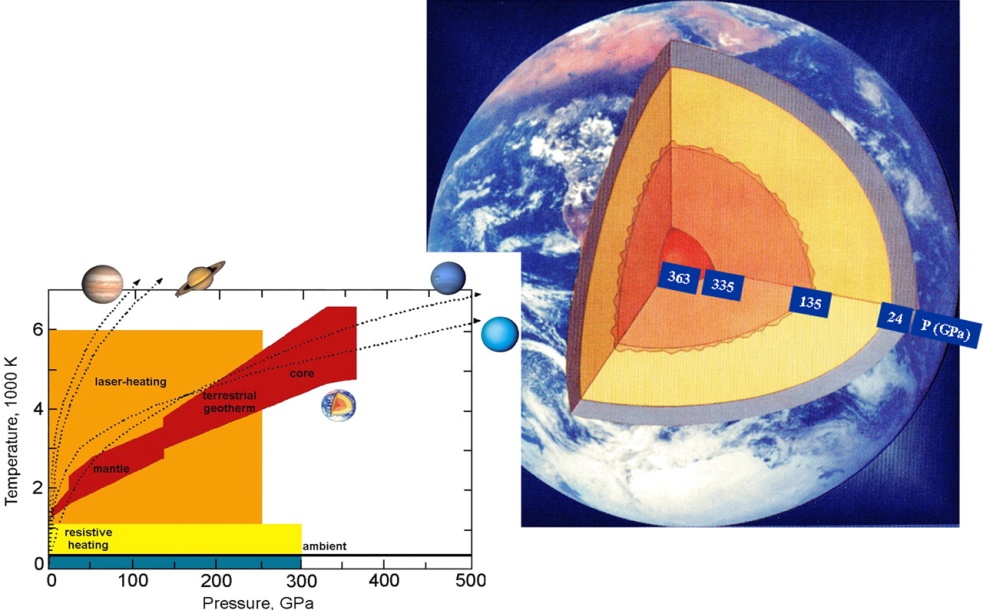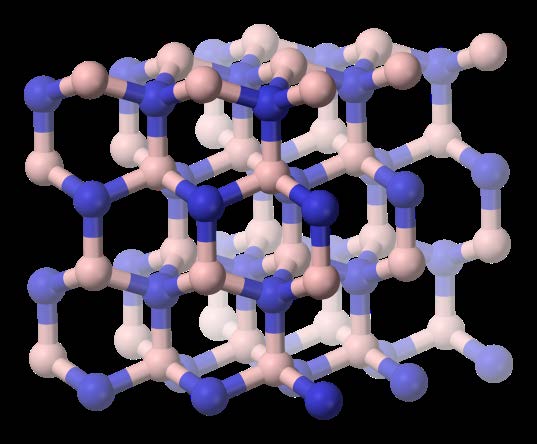Exploring polymorphism in molecular compounds using high pressure

High-Pressure Crystallography
Francesca P. A. Fabbiani
Emmy-Noether Jr. Research Group



Introduction to high-pressure
Dr. Michael Ruf
Experimental setup
Product Manager, SC-XRD Madison, WI, USA
Dr. Francesca P. A. Fabbiani
High-pressure crystallography with
Collecting high-pressure data,
emphasis on single-crystal X-ray structure determination
solving and refining structures
High-pressure crystallization Solid-state polymorphism Molecular compounds with
emphasis on pharmaceuticals and
Molecular organic
materials, single crystals
Introduction to
High-Pressure Research


High-Pressure Research
Range of pressures and temperatures now accessible
with static compression techniques in the laboratory.
Planetary science and physics (e.g. minerals, perovskites, clathrates, ices – N.B. 15 polymorphs of H O
Synthesis of novel materials (e.g. superhard materials, nanoporous materials, MOFs)
Mao H , Hemley R J PNAS 2007;104:9114-9115
2007 by National Academy of Sciences
Chemistry/molecular compounds
Phase diagram of water
(e.g. amino acids, molecular magnets, pharmaceuticals)
Proteins, pressure-induced denaturation, folding
Source: Martin Chaplin, http://www.lsbu.ac.uk/water/phase.html


High-Pressure Research
Industrial applications, e.g. pressure treatment of food
Origin of life/ sustained life at the bottom of the oceans
Source: Wikimedia Commons
Access new materials, probe
intermolecular interactions
Understand polymorphic
Source: Wikimedia Commons
Interplay with theory
Source: Wikimedia Commons
High-Pressure Scale
(1000 atmospheres ≈ 1 kbar = 100 MPa = 0.1 GPa)
intergalactic inside a light
10-16 10-5 10-4 10-2 10-1
Molecular materials
Orders of magnitude available for pressure variation >> temperature variation
Experimental Setup
Pressure Generation for in situ XRD:
Diamond-Anvil Cell
First diamond anvil cell at NIST Gaithersburg Museum
Aluminium DAC mounted on a
DAC manufactured by Dr. H. Ahsbahs
F. P. A. Fabbiani et al. CrystEngComm
(2010), 12, 2354-2360
Source: G. J. Piermarini, Wikimedia Commons
Pressure Generation for in situ XRD:
Diamond-Anvil Cell
P= F/A (kgms-2/m2 = N/m-2 = Pa)
Tightening screws
Choose your DAC carefully: backing plates material, diamond cut, purity and culet size, gasket hole size, DAC opening angle
DAC Loading
Prepare gasket, i.e. sample chamber
Equipment for DAC preparation
• EDM machine (spark eroder) or
Load sample together with pressure
laser to drill gasket hole
calibrant, e.g. ruby chip
• Stereomicroscope with good
(fluorescence) or quartz single crystal
magnification, large working
distance and polariser/analyser
• Small spectrometer with large
Sample can be in the solid (direct
working distance to monitor ruby
compression in an hydrostatic
fluorescence if using ruby as
medium), liquid or gas phase (in situ
pressure calibrant
crystal growth). A solution can also be loaded for in situ crystal growth
DAC Loading
Three main sample loading methods available
Sample loading methods depend on:
Nature of the sample under investigation
Aim of experimental investigation
The focus here is on molecular organic materials for single-crystal X-ray diffraction
"Fathers" of high-pressure research: G. H. J. A. Tammann (1861-1938), P. W. Bridgman (1882-1961)
DAC Loading
Approach 1: Direct compression in a hydrostatic medium
Good for studying polymorphism in small molecules
Less effective for studying polymorphism in larger and/or rigid molecules: kinetic barrier associated with molecular rearrangement is usually large
Good for studying evolution of structure as a function of pressure, for obtaining p-T phase diagrams and isothermal equation of states
Choice of hydrostatic medium: solubility/ freezing pressure considerations
DAC Loading
Approach 2: In situ crystallisation and growing from the melt
Excellent method for crystallising new polymorphs of compounds with melting points < 40°C and for comparing with low-temperature structures
Not effective for higher melting organic compounds, which
can decompose before the onset of melting
DAC Loading
Approach 2: In situ crystallisation and growing from the melt
DAC Loading
Approach 3: In situ crystallisation from solution
Excellent method for crystallising new polymorphs and solvates. No limitation to low melting point or small molecules
Can vary solvent, pressure, temperature and concentration
Prerequisite: relatively high solubility of the solute; solubility of solute increases with increasing temperature and decreases with increasing pressure
Introduction to high-pressure research
Experimental setup
Collecting high-pressure data, solving and refining structures
Molecular organic materials, single crystals
Collecting high-pressure
data, solving and refining
structures
Data Collection
Centre on the diffractometer, 2-step
Set up @ GZG Göttingen
procedure: optical centring and direct beam centring (Dawson et al. 2004) or diffractometric measurements (King & Finger 1979, Dera &
Short collimator and long beamstop
Choose suitable data collection
Diffracted beam D
strategy (and wavelength, if applicable) and exposure time;
Data collection in
transmission mode
maximise no. frames per run (this helps during data integration if integrating with Bruker software)
A. Dawson et al. J. Appl. Cryst. (2004), 37, 410-416
H. E. King & L. W. Finger J. Appl. Cryst. (1979), 12, 374-378
P. Dera & A. Katrusiak J. Appl. Cryst. (1999), 32, 510-515
Data Collection
For one orientation of the DAC, the
accessible region of reciprocal space
is determined by the detector distance
and the DAC opening angle
By a combination of ω-scans using
different orientations of the DAC in φ,
and different orientations of the
Steel support of the DAC
detector in 2θ, about ⅓ of all
starting to obscure the
reflections can be collected (Angel et
al. 1992). This can be increased by
collecting more data with a different
orientation of the DAC with respect to χ (see later)
R. J. Angel et al. Phase Transitions (1992), 39, 13-32
Data Collection
Example of data collection strategy for a 3-circle diffractometer, detector distance = 7 cm and DAC perpendicular to the beam @ phi = 0°, ½ DAC opening angle = 45°
2 Theta Omega Phi
Sweep Scan direction
Important: check hardware limits; check diffraction limits and adjust 2 Theta and Omega accordingly
Data Collection
Set up @ GZG Göttingen
X-ray Crystallography
Diffracted beam D
Limited sampling of reciprocal space
data completeness and resolution
structure solution
Sample scattering
power (and size)
structure refinement
Data Completeness
Coverage of reciprocal space
Increasing Data Completeness
Rotate by 120°
Rotate by 120° On a 3-circle
and collect
and collect
Rotation of the DAC
DAC with large opening angle + non-diffracting backing plates
Data collection with short-wavelength radiation (see later)
Careful orientation of the crystal in the DAC (ambient p)
Multiple or twinned crystals
F. P. A. Fabbiani et al. CrystEngComm (2010), 12, 2354-2360
Data Processing
Data indexing identify reflections arising from sample
Harvesting reflections
If large background variations, reduce the number of images and runs
Choose an appropriate value
It is useful to exclude certain regions, e.g. Be rings, gasket rings; if sample reflections are scarce and indexing is difficult, try omitting high-resolution regions, where diamond reflections are more abundant. This can also be achieved through a reciprocal lattice viewer (recommended)
Data Processing
Data indexing identify reflections arising from sample
Reciprocal lattice viewer
The reciprocal lattice viewer is an invaluable tool for indexing, for assessing data quality and for twin-spotting. Reflections can be conveniently assigned to different groups and exported for indexing with external programs, e.g. CELL_NOW
Data Processing
Data indexing identify reflections arising from sample
Data integration mask out regions of detector obscured by the DAC; choose appropriate resolution; background correction
The following are recommendations based on personal experience. There is no "one-fits-all" strategy that will work for every sample: try different options to optimise your integration.
Once the integration parameters have been optimised, I would strongly recommend performing successive integration cycles ("UB matrix update") for best intensities and unit cell parameters
Data Processing
Data indexing identify reflections arising from sample
Data integration mask out regions of detector obscured by the DAC; choose appropriate resolution; background correction
Try to keep the box size small. If problems with convergence: uncheck this option
If background is jumpy choose high frequency; otherwise reduce
Twins can be easily handled
Data Processing
Data indexing identify reflections arising from sample
Data integration mask out regions of detector obscured by the DAC; choose appropriate resolution; background correction
This option might be useful for synchrotron data
Threshold for strong reflections: lower this to, e.g. 8 for weak data
For using dynamic masks generated with an external program
Data Processing
Typical frames from CCD Area Detector
Powder ring from
almost invisible at
2θ = 0 (gasket and
Powder ring from
Shading from DAC opening
Dynamic masks: A. Dawson et al. J. Appl. Cryst. (2004), 37, 410–416; N. Casati et al. J. Appl. Cryst. (2004), 40, 620-630
Data Processing
Data indexing identify reflections arising from sample
Data integration mask out regions of detector obscured by the DAC; choose appropriate resolution; background correction
Generate dynamic masks "on the fly", e.g. with the Bruker SAINT integration software, V8.07A run from the command line ("Advanced options")
Input DAC geometry
Data Processing
Data indexing identify reflections arising from sample
Data integration mask out regions of detector obscured by the DAC; choose appropriate resolution; background correction
Scaling and absorption correction 2-stage procedure: analytical correction for DAC components and gasket shadowing, see programs by S. Parsons, A. Katrusiak and R. J. Angel; multiscan correction to correct for other systematic errors and for scaling, e.g. SADABS. Beware of outliers, e.g. diamond reflections!
Space group determination difficulty related to completeness, redundancy, resolution and crystal orientation systematic absences are not always present
Data Processing
Structure solution direct methods, global optimisation methods (borrowed from powder diffraction), molecular replacement, etc.: numerous programs available!
Data merging crucial step; robust-resistant and experimental (1/σ2) weighting scheme with SORTAV
SORTAV: R. H. Blessing J. Appl. Cryst. (1995), 30, 421–426
Refinement
Very high-quality high-pressure data can be collected nowadays. It is nevertheless important to be realistic during refinement. Refinement of ADPs for all non-H atoms might not be possible
Most commonly encountered problem: low data to parameter ratio; restraints are your friends: treat them well and be generous
Always investigate outliers before omitting reflections: go back to the original frames
The following are examples taken from my own research
CRYSTALS: P. W. Betteridge et al. J. Appl. Cryst. (2003), 36, 1487
SHELXL: G. M. Sheldrick Acta Cryst. (2008), A64, 112-122
Refinement
Example of problematic data, lab source
In situ crystallisation study
Cell setting, space group
Monoclinic, P2 /n
Constraints: 2 rigid bodies
a, b, c (Å)
7.630(2) 17.209(3) 7.3708(11)
1 isotropic parameter
Multi-scan abs. correction T
No. of measured, independent and
observed [F > 4σ(F)] reflections
No. of parameters
R [F > 4σ(F)], wR (F2, all reflections)
(Å-1) and completeness (%)
Structure solution: DASH
Refinement program: CRYSTALS
Refinement
Example of good data, lab source
In situ crystallisation study
Cell setting, space group
Monoclinic, P2 /c
a, b, c (Å)
8.9537(11) 5.4541(6) 13.610(4)
SIMU, DELU, DFIX [for (N)H
positions] restraints
Multi-scan abs. correction T
No. of measured, independent and
observed [F > 4σ(F)] reflections
No. of parameters and restraints
R [F > 4σ(F)], wR (F2, all reflections)
(Å-1) and completeness (%)
Structure solution: Sir92
Refinement program: CRYSTALS
Refinement
Example of good data, lab source
Here would expect diamond overlaps
Overlap with gasket
Shaded reflections
Increasing data quality – Part I
Synchrotron radiation
Useful properties of synchrotron radiation:
Brilliance gain in diffracted
intensity compared to a lab source,
i.e. increase in resolution and
Tuneable wavelength: short-
wavelength radiation is accessible less absorption and significant gain in completeness
n = 2d sinθ
Small source size: microfocussing is possible very small samples can be investigated; reduction/elimination of gasket diffraction
Refinement
Example of good data, synchrotron radiation
In situ crystallisation study
SIMU, DELU restraints
Cell setting, space group
All H-atoms could be located on difference Fourier maps
Triclinic, P-1
a, b, c (Å)
6.7906(12) 7.3159(4) 15.8428(14)
α, β, γ (°)
86.297(6) 78.924(11) 72.713(6)
Multi-scan abs. correction T
No. of measured, independent and
6429, 1533, 1294
observed [F > 4σ(F)] reflections
No. of parameters and restraints
R [F > 4σ(F)], wR (F2, all reflections)
C H NO . 7(H O)
(Å-1) and completeness (%)
Structure solution: Sir92
Refinement program: CRYSTALS
Refinement
Example of good data on a large molecule, synchrotron radiation
Compression study
SIMU, DELU, DFIX restraints
High pressure (1.0 GPa)
High pressure (1.0 GPa)
Cell setting, space group
Orthorhombic, P2 2 2
a, b, c (Å)
15.9455(4) 21.0511(5) 23.8739(8)
Multi-scan abs. correction T
No. of measured, independent and
53048, 10032, 7534
observed [F > 4σ(F)] reflections
No. of parameters and restraints
R [F > 4σ(F)], wR (F2, all reflections)
(Å-1) and completeness (%)
C H CoN O P . 22 H O
Structure solution: (SHELXS)
Refinement program: SHELXL
Refinement
Example of good data on a large molecule, synchrotron radiation
Ambient-pressure and temperature study
SIMU, DELU, DFIX restraints
Ambient pressure
Ambient pressure
Cell setting, space group
Orthorhombic, P2 2 2
a, b, c (Å)
15.8260(9) 22.4438(13) 25.4429(16)
Multi-scan abs. correction T
No. of measured, independent and
101570, 26484, 19937
observed [F > 4σ(F)] reflections
No. of parameters and restraints
R [F > 4σ(F)], wR (F2, all reflections)
(Å-1) and completeness (%)
C H CoN O P . 23.5 H O
Structure solution: (SHELXS)
Refinement program: SHELXL
Refinement
Example of good data on a large molecule, synchrotron radiation
Water ordering in channels at high pressure
High pressure (1.0 GPa)
Ambient pressure
Electron density maps generated with shelXle,
Fo-Fc @ 0.31 e-/Å3, Fo @ 0.98 e-/Å3
ShelXle: C. B. Hübschle et al. J. Appl. Cryst. (2011), 44, 1281-1284
Increasing data quality – Part II
Synchrotron radiation
Useful properties of synchrotron radiation:
Shorter wavelength less
absorption, more diffraction data and
smaller diffraction angles
Ag radiation (0.56087 Å) is now
available as an air-cooled 30 W microsource (supplier: Incoatec)
n = 2d sinθ
increase in data completeness, "cleaner" background
Ag radiation in the lab
Comparative study on gabapentin heptahydrate, Incoatec Ag microsource vs. Mo sealed tube on a Bruker AXS Apex II diffractometer
Ag-IµS, 90 µm beam
Mo-sealed tube, 500 µm beam
Exposure time (s/0.3°)
<I>
<I/σ>
<Redundancy>
<Completeness>/%
R (I<2σ(I))
Number in parenthesis refer to the highest resolution shell (1.00 – 0.90 Å)
Fore more information: http://www.incoatec.de/?id=101
Further Reading
Further Reading
High-Pressure Crystallography
Prof. Simon Parsons (Edinburgh)
Dr. Heidrun Sowa (Göttingen)
Dr. Jürgen Graf (Incoatec)
Dr. Michael Ruf (Bruker)
Question & Answer
Questions?
Type any questions you may have
into the Q&A panel, then click Send.
Thank you for joining!
A PDF copy of the slides and a link to the recording of this webinar will be emailed to you.
For more Bruker SC-XRD webinars, visit
Source: https://bruker.cn/fileadmin/user_upload/8-PDF-Docs/X-rayDiffraction_ElementalAnalysis/SC-XRD/Webinars/Bruker_AXS_High-Pressure_Crystallography_Webinar_20111206.pdf
The Journal of Emergency Medicine, Vol. -, No. -, pp. 1–9, 2015 Copyright Ó 2015 Elsevier Inc. Printed in the USA. All rights reserved 0736-4679/$ - see front matter Pharmacology inEmergency Medicine A RANDOMIZED CONTROLLED TRIAL OF INTRAVENOUS HALOPERIDOL VS. INTRAVENOUS METOCLOPRAMIDE FOR ACUTE MIGRAINE THERAPY IN THE EMERGENCY DEPARTMENT Matthew E. Gaffigan, MDDavid I. Bruner, MD,† Courtney Wason, BSAmy Pritchard, DO,‡ and
HELICOBACTER PYLORI: UPDATE The role of Helicobacter Pylori (HP) in gastric The Medical Benefits Schedule The PyTest® has several ulcers has been wel established by Nobel changed in November 2006 advantages over other tests for Prize winners Professor Barry Marshal and to rebate diagnostic breath HP and is now available through Dr Robin Warren. Australian researchers Professor Barry Marshall








